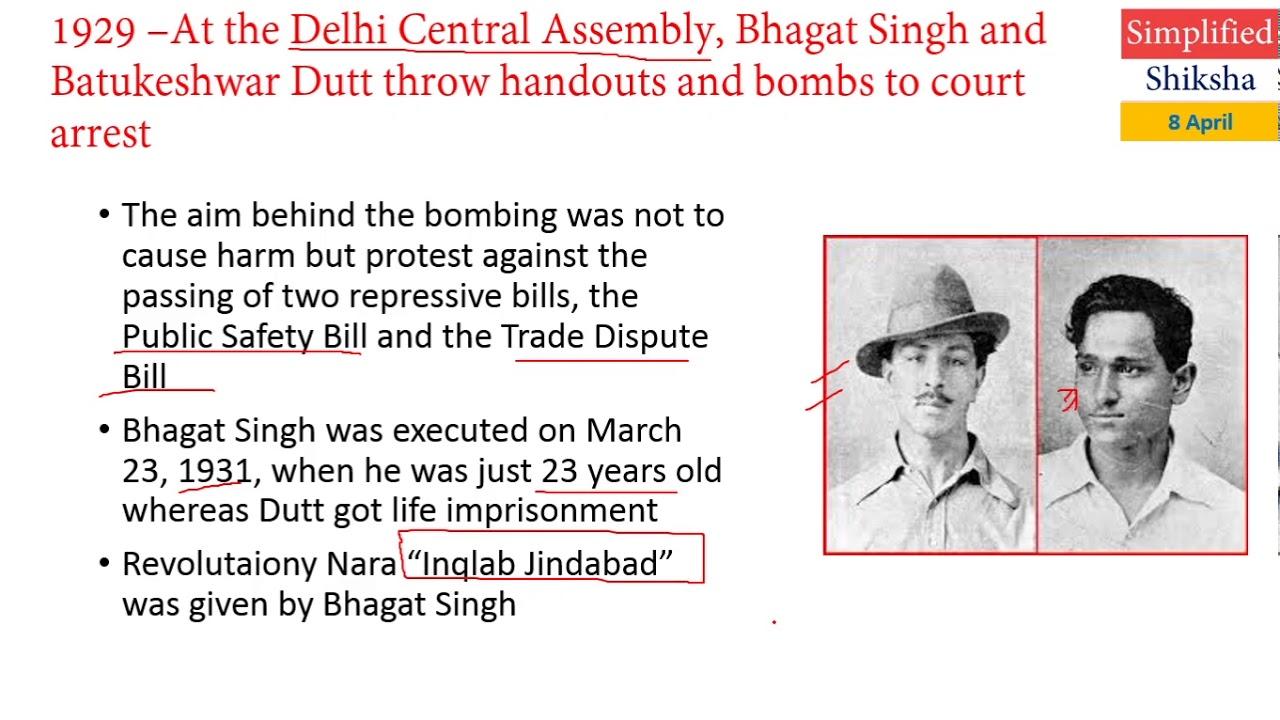Delhi Assembly bombing and arrest:
For some time, Bhagat Singh had been exploiting the power of drama as a means to inspire the revolt against the British, purchasing a magic lantern to show slides that enlivened his talks about revolutionaries such as Ram Prasad Bismil who had died as a result of the Kakori conspiracy. In 1929, he proposed a dramatic act to the HSRA intended to gain massive publicity for their aims. Influenced by Auguste Vaillant, a French anarchist who had bombed the Chamber of Deputies in Paris, Singh's plan was to explode a bomb inside the Central Legislative Assembly. The nominal intention was to protest against the Public Safety Bill, and the Trade Dispute Act, which had been rejected by the Assembly but were being enacted by the Viceroy using his special powers; the actual intention was for the perpetrators to allow themselves to be arrested so that they could use court appearances as a stage to publicise their cause.
The HSRA leadership was initially opposed to Bhagat's participation in the bombing because they were certain that his prior involvement in the Saunders shooting meant that his arrest would ultimately result in his execution. However, they eventually decided that he was their most suitable candidate. On 8 April 1929, Singh, accompanied by Batukeshwar Dutt, threw two bombs into the Assembly chamber from its public gallery while it was in session. The bombs had been designed not to kill, but some members, including George Ernest Schuster, the finance member of the Viceroy's Executive Council, were injured. The smoke from the bombs filled the Assembly so that Singh and Dutt could probably have escaped in the confusion had they wished. Instead, they stayed shouting the slogan "Inquilab Zindabad!" ("Long Live the Revolution") and threw leaflets. The two men were arrested and subsequently moved through a series of jails in Delhi.
For some time, Bhagat Singh had been exploiting the power of drama as a means to inspire the revolt against the British, purchasing a magic lantern to show slides that enlivened his talks about revolutionaries such as Ram Prasad Bismil who had died as a result of the Kakori conspiracy. In 1929, he proposed a dramatic act to the HSRA intended to gain massive publicity for their aims. Influenced by Auguste Vaillant, a French anarchist who had bombed the Chamber of Deputies in Paris, Singh's plan was to explode a bomb inside the Central Legislative Assembly. The nominal intention was to protest against the Public Safety Bill, and the Trade Dispute Act, which had been rejected by the Assembly but were being enacted by the Viceroy using his special powers; the actual intention was for the perpetrators to allow themselves to be arrested so that they could use court appearances as a stage to publicise their cause.
The HSRA leadership was initially opposed to Bhagat's participation in the bombing because they were certain that his prior involvement in the Saunders shooting meant that his arrest would ultimately result in his execution. However, they eventually decided that he was their most suitable candidate. On 8 April 1929, Singh, accompanied by Batukeshwar Dutt, threw two bombs into the Assembly chamber from its public gallery while it was in session. The bombs had been designed not to kill, but some members, including George Ernest Schuster, the finance member of the Viceroy's Executive Council, were injured. The smoke from the bombs filled the Assembly so that Singh and Dutt could probably have escaped in the confusion had they wished. Instead, they stayed shouting the slogan "Inquilab Zindabad!" ("Long Live the Revolution") and threw leaflets. The two men were arrested and subsequently moved through a series of jails in Delhi.
Delhi Assembly bombing and arrest:
For some time, Bhagat Singh had been exploiting the power of drama as a means to inspire the revolt against the British, purchasing a magic lantern to show slides that enlivened his talks about revolutionaries such as Ram Prasad Bismil who had died as a result of the Kakori conspiracy. In 1929, he proposed a dramatic act to the HSRA intended to gain massive publicity for their aims. Influenced by Auguste Vaillant, a French anarchist who had bombed the Chamber of Deputies in Paris, Singh's plan was to explode a bomb inside the Central Legislative Assembly. The nominal intention was to protest against the Public Safety Bill, and the Trade Dispute Act, which had been rejected by the Assembly but were being enacted by the Viceroy using his special powers; the actual intention was for the perpetrators to allow themselves to be arrested so that they could use court appearances as a stage to publicise their cause.
The HSRA leadership was initially opposed to Bhagat's participation in the bombing because they were certain that his prior involvement in the Saunders shooting meant that his arrest would ultimately result in his execution. However, they eventually decided that he was their most suitable candidate. On 8 April 1929, Singh, accompanied by Batukeshwar Dutt, threw two bombs into the Assembly chamber from its public gallery while it was in session. The bombs had been designed not to kill, but some members, including George Ernest Schuster, the finance member of the Viceroy's Executive Council, were injured. The smoke from the bombs filled the Assembly so that Singh and Dutt could probably have escaped in the confusion had they wished. Instead, they stayed shouting the slogan "Inquilab Zindabad!" ("Long Live the Revolution") and threw leaflets. The two men were arrested and subsequently moved through a series of jails in Delhi.
0 Comments
0 Shares
0 Reviews




